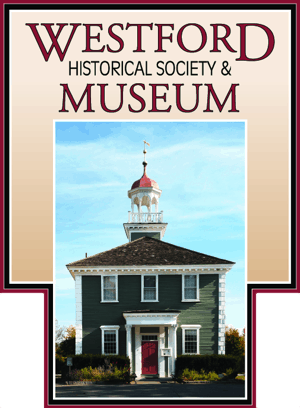Complied by Marilyn Day
Introduction by Linda Greene
Today’s snowstorm has put the reliable gasoline-powered snowplow into action, equipped with flashing lights, a radio, and a heated cab for comfort. As it diligently clears the highways for safer travel, it’s interesting to reflect on the past when horse-drawn sleds and sleighs were the primary means of winter transportation—a nostalgic reminder of our progress in managing winter challenges!
Snow rollers have historically played a vital role in the efficient compaction of snow on busy roadways. The operation of these rollers produces reassuring sounds, including the gentle squeak and crunch of the machinery, along with the jingle of bells attached to the horses or oxen. Unlike contemporary snow removal machines, snow rollers were designed without a cab. Instead, they were operated by two individuals dressed in warm fur coats and blankets, ensuring comfort during colder months. Additionally, snow rollers facilitated the clearing and compacting of driveways, contributing to smoother winter travel by pungs, a low wooden sled with wooden runners used for hauling goods, sleds, or sleighs for all road users
Photo: Snow Roller and Horse Team in Dublin, New Hampshire; Keene Public Library and the Historical Society of Cheshire County
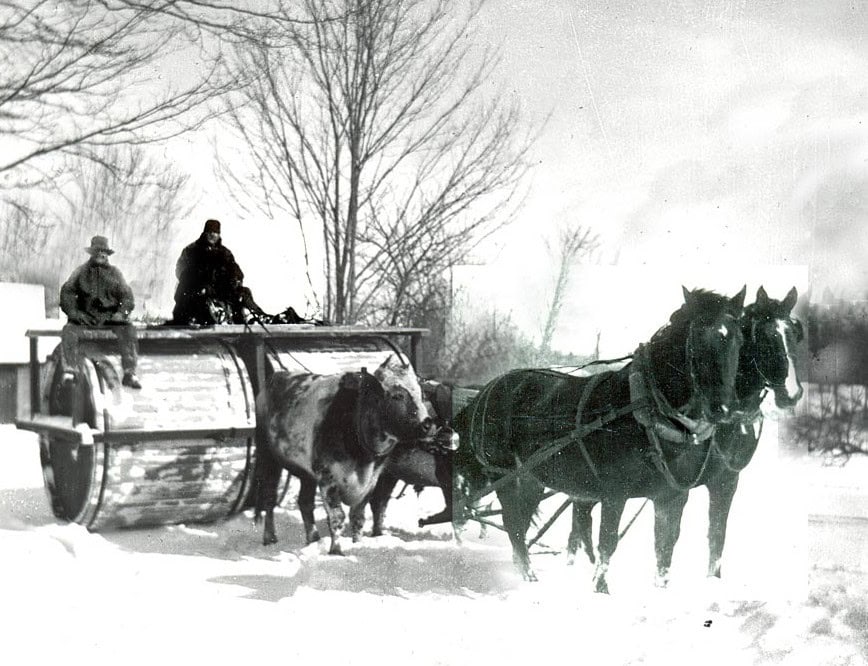
The History of Westford’s Three Town-owned Snow Rollers.
Annual Town Meeting was held on March 21, 1904. Article 28 stated: “To see if the Town will authorize the Selectmen to investigate and purchase one or more Snow Rollers for the purpose of breaking roads in winter if, in their judgment, they are of practical use and act in relation to the same.” (1904 Town Report, p. 113)
The result of that meeting published in the 1905 Annual Town Report, p. 17, stated, “28. Voted that Selectmen be authorized and instructed to investigate and report at the next annual town meeting the advisability of purchasing snow rollers.”
At the town meeting held on March 20, 1905, Article 5 stated, “To hear the report of the Selectmen regarding the purchase of snow rollers, and act in relation to the same.”
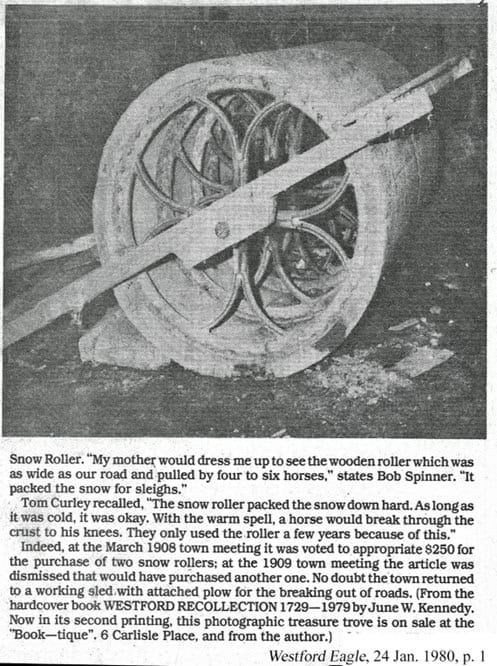
REPORT OF SELECTMEN IN REGARD TO PURCHASING A SNOW ROLLER.
After consulting both personally and by letter with Selectmen of various towns having experience with snow rollers, they are unanimous in the opinion that by using such rollers, an excellent road is made, varying from 12 to 15 feet in width. To accomplish this, it requires six horses to draw the roller, and where deep drifts are encountered, the snow has to be shoveled out the full width of the roller before passing. On this account, it would seem to be an impractical method of breaking roads except on main highways and in villages. (Town Report year ending March 1, 1905, p. 49)
The results of the March 20, 1905 meeting were published in the 1906 Town Report, p. 15, and stated, “5. Voted to accept the report of the Selectmen on snow rollers, with instructions to purchase a snow roller not to exceed ten feet in width.”
The Annual Town Report for the year ending 1906, p. 39, showed payment to James Walkden for a snow roller. “J. A. Walkden, snow roller $65.00.” James Walkden ran the wheelwright shop located on Main Street and east of Chamberlin Road.
(A family in Westford once owned the snow roller in the article to the left. It would have been used for roads on the farm. It is 7 feet wide and 3.5 feet in diameter, much smaller than the ones the town bought. Today, the snow roller is being restored by the Westford Museum and Historical Society )
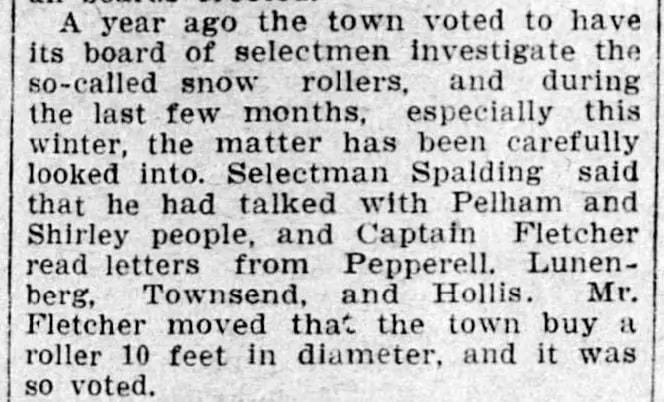
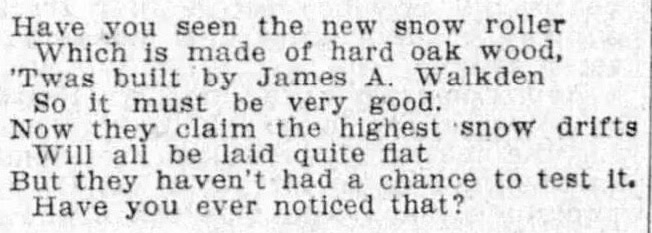
From a poem called “Have You Ever Noticed That,” read at the Westford Grange and published in the Lowell Courier Citizen, March 6, 1906, p. 3
The schedule of property belonging to the town for the use of the Road Department in 1906 included 1 snow roller. (Annual Town Report, year ending March 1, 1907, p. 51
Westford Wardsman, Saturday, January 13, 1906. About Town. The snow roller that the town voted for at the last annual meeting is being built in the wheelwright shop of J. A. Walkden. The vote should be reconsidered or the weather reconstructed to bring forth a blending of conditions. As the weather won’t mind us, it is moved to reconsider the vote until there is a snowstorm.
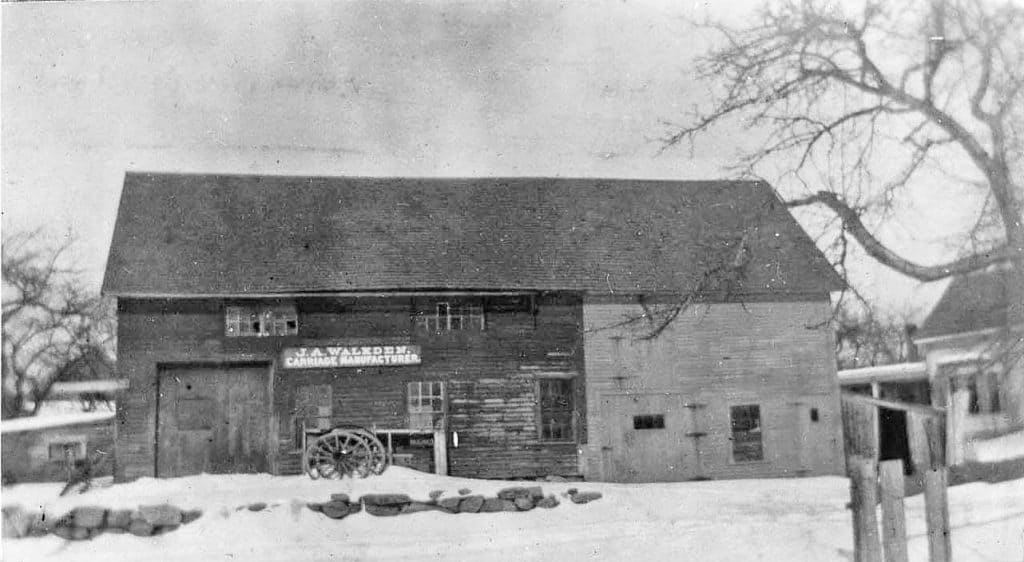
“James A. Walkden has sold his wheelwright shop and contents to the H. E. Fletcher Granite Company on Oak hill, and it is being razed by the laws of gravitation… Thus an old landmark of Chamberlin’s corner is passing away to be a new landmark in the new and progressive activities of Oak hill” (Westford Wardsman, July 8, 1922).
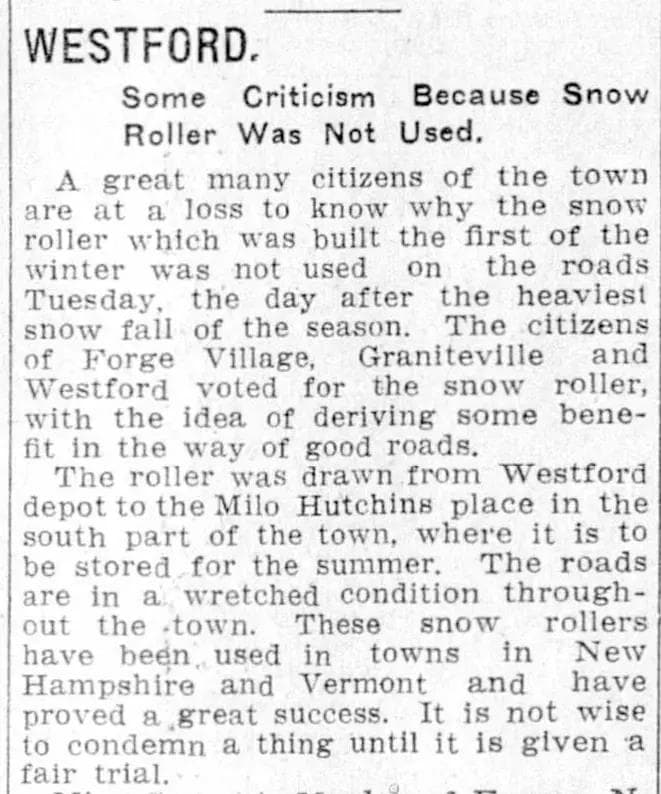
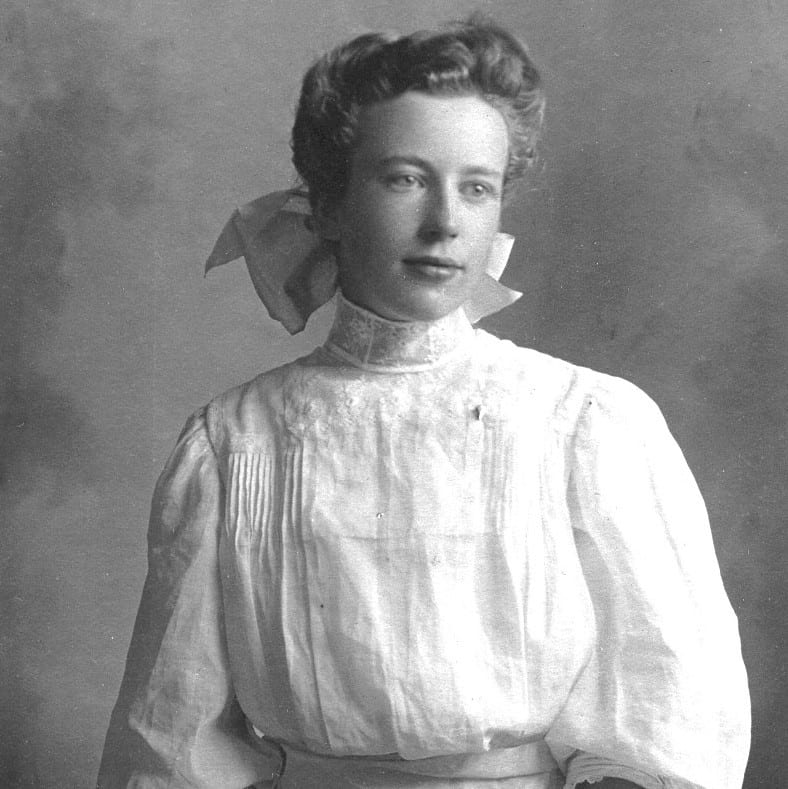
From the diary of May E. Day, Wednesday, February 6, 1907
Got up 6:15, blacked my shoes. Hash for breakfast. Wore my over-shoes & stockings. Started just before 8. Followed Miss T. from store. Asked Mr. P. [Mr. Putney] about Cic. [Cicero, i.e. Latin] 12 out. 14 in afternoon… Roller been over the roads. Good walking…
Photo: From the Collection of the Westford Museum
May Day c. 1908
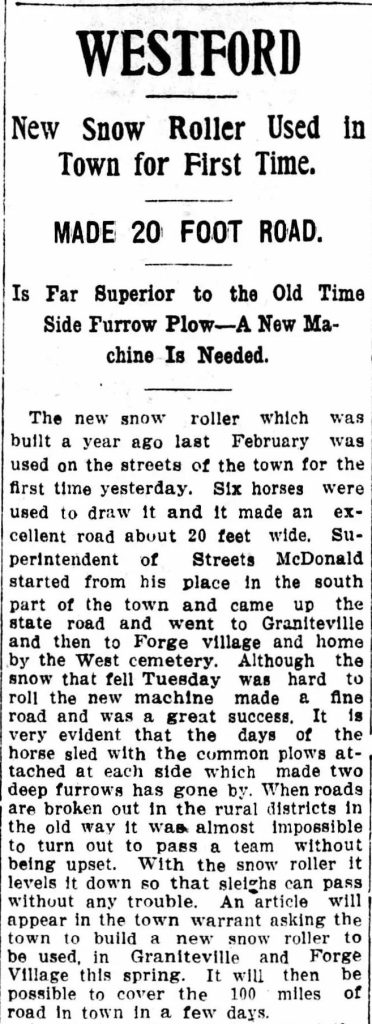
Westford Wardsman, February 23, 1907. “About Town. The snow roller for our roads has been tried before a jury of 2600 people recently, and while in all probability the jury will not return a unanimous verdict in its favor at the annual meeting in March, yet there is one of this jury that is so unanimous in its favor that he will vote away the people’s money to build another. With wider roads at less expense the verdict should be an easy one for the jury to agree on.”
The Lowell Courier Citizen of March 6, 1907, reported, “There are many important articles in the warrant, namely: to see if the town will appropriate money for additional snow rollers…”
Annual Town Meeting, March 18, 1907: Article 21. Voted that $250 be appropriated for the purchase of two snow rollers, one to be stationed at Graniteville and one at Brookside or vicinity, and the diameter of such rollers be not less than six feet.
The 1908 town report, p. 57, showed that George W. Tibbitts (sic Tibbetts) was paid $200.00 for two snow rollers. Freight amounted to 21.62. Appropriation, $250.00.
In 1907, the schedule of property owned by the town of Westford showed 3 snow rollers. (Annual Report, year ending, March 1, 1908, p. 63)
The 1906 Rindge, New Hampshire, Town Report shows that Rindge paid George W. Tibbetts $100 for a snow roller plus $10 shipping. The town of Newbury, N.H., also bought three snow rollers from George W Tibbetts in 1911.
George W. Tibbetts had two office locations, one in S. Berwick, Maine, and the other at the New England House in Boston. His Maine death record indicated he was an Agent.
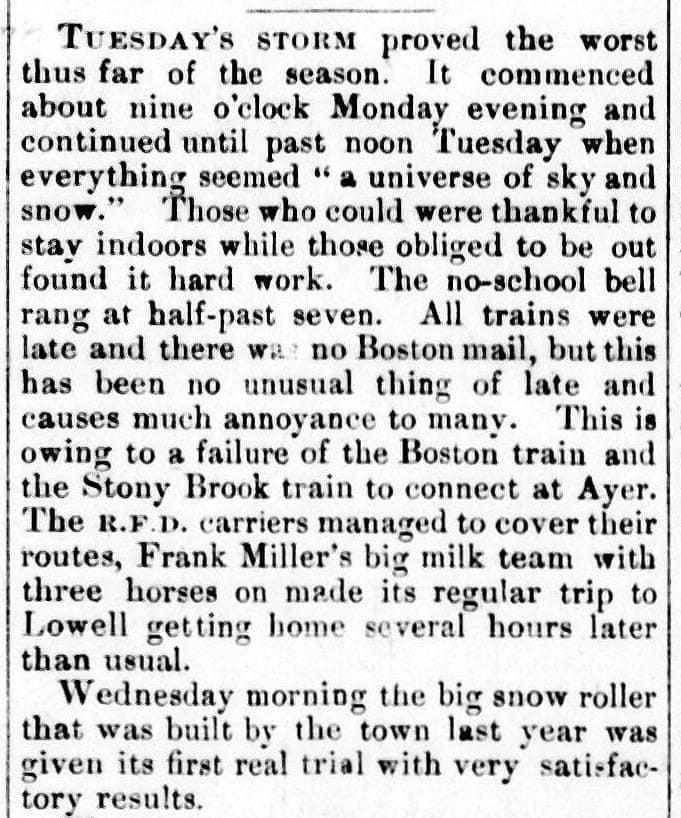
Lowell Courier Citizen, February 7, 1907, p. 3
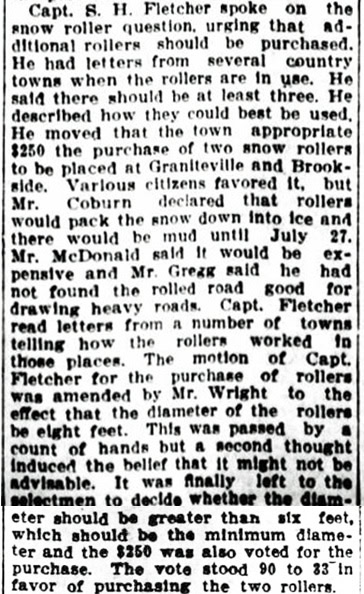
The Wardsman reported the following on March 23, 1907. “Additional snow rollers that got rolled into Article 21, received a very versified treatment. Capt. S. H. Fletcher championed the defense of this modern method of dealing with winter snow, reading several letters from different sections of New England, demonstrating their efficiency. Finally enough voters exchanged antiquated ideas for modern ideas of breaking roads, and the town ordered two new rollers, not to be less than six feet in diameter, and more if practicable, to be located at Graniteville and Brookside.”
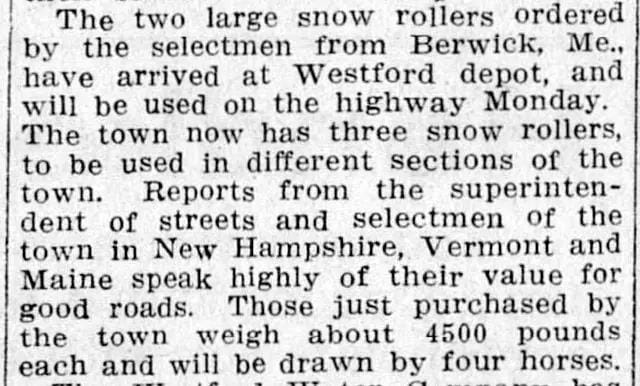
Lowell Courier Citizen, December 16, 1907, p .5
Lowell Courier Citizen, March 19, 1907, p. 3
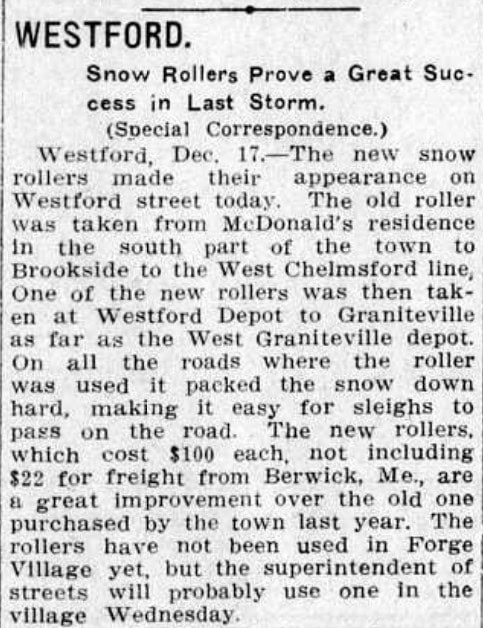
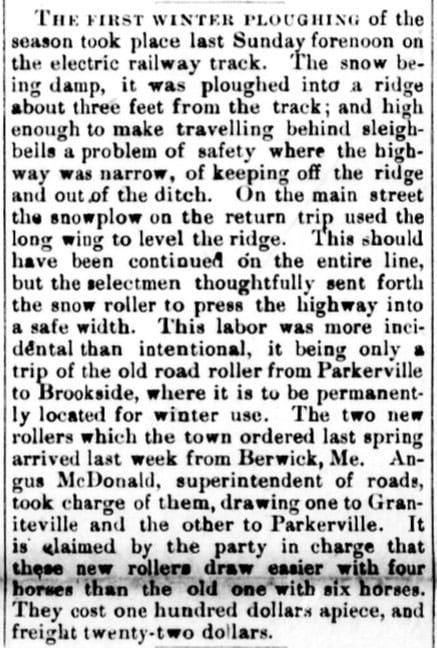
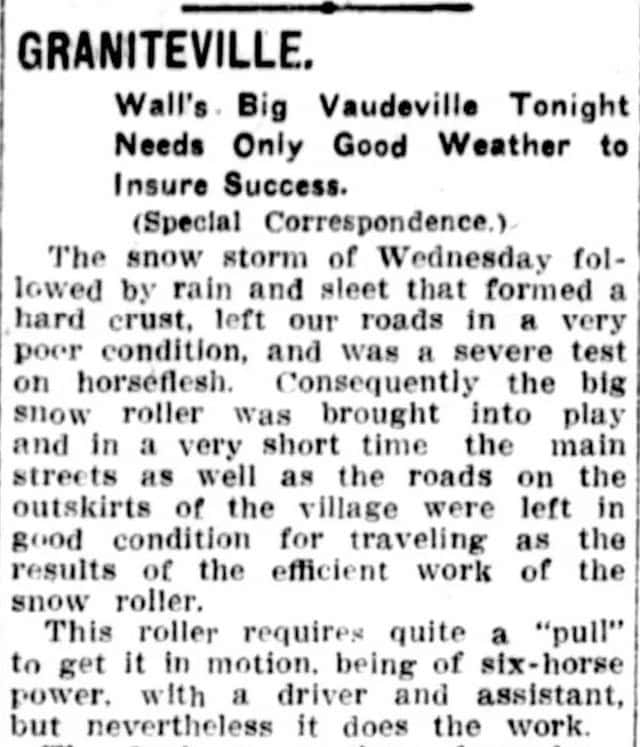

Town meeting was held on Monday March 16, 1908. Article 22, To see if the Town will vote to purchase a road roller.
Westford Wardsman, March 21, 1908. “Town Meeting. Last Monday the town held its 179th annual meeting, with the usual characteristic features incident to such New England gatherings; 329 voters recorded their opinions by ballot for the choice of town officers. …
The road roller article was dismissed for lack of a defendant and the thought that the town already has investments in the unhoused rollers.”
“Voted to dismiss Article 22. This article was to see if the Town would vote to purchase a road roller.”
(Annual Reports of the Town of Westford for the Year Ending February 1, 1909, “Annual Town Meeting, March 16, 1908,” p. 17).
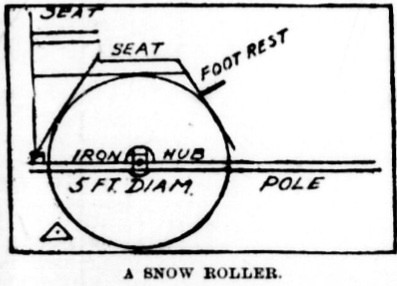
Westford Wardsman, February 20, 1909. Roads After a Snowstorm. R.G. Brock, a Vermont man, tells in the Rural New Yorker how to use and make a snow roller.
“Snow rollers,” he says, “are used for rolling the highways after a snowstorm to pack the snow down, which, when frozen, makes a road ten feet wide. The diagram shows that they are made with two drums four and a half feet long and five feet in diameter, with a two-inch steel shaft running through in which the drums turn independently, thus permitting them to turn a corner easily. The drums are made of two-inch oak, the heads being double and hooped with two-by-half-inch tire iron. The drums are hung in a strong frame, the pole goes through between them, and they are about a foot apart. A seat frame is placed on the mainframe over the drums, with a place for tools, etc. Four horses are required to haul the snow roller on the level river roads and six on the hill roads.”
On April 3, 1909, the Wardsman reported that Westford Selectmen had appointed Frank E. Miller Superintendent of Streets. He had outbid John A. Healy, Fred A. Shorey, and Angus McDonald for the position.
Westford Wardsman, April 10, 1909. “About Town. One of the expensive snow rollers built for the town two years ago is being sheltered from the wear, tear and warping of the weather by the sky that is stretched over Westford corner. This roof certainly didn’t leak much last summer, but it is hoped for the sake of farm crops, it will commence to leak more this season. It is reported that Chelmsford wants to buy a roller. Why not push this roller over the line, and tell Chelmsford folks to help themselves? It will save our repairing the roof where it is housed.”
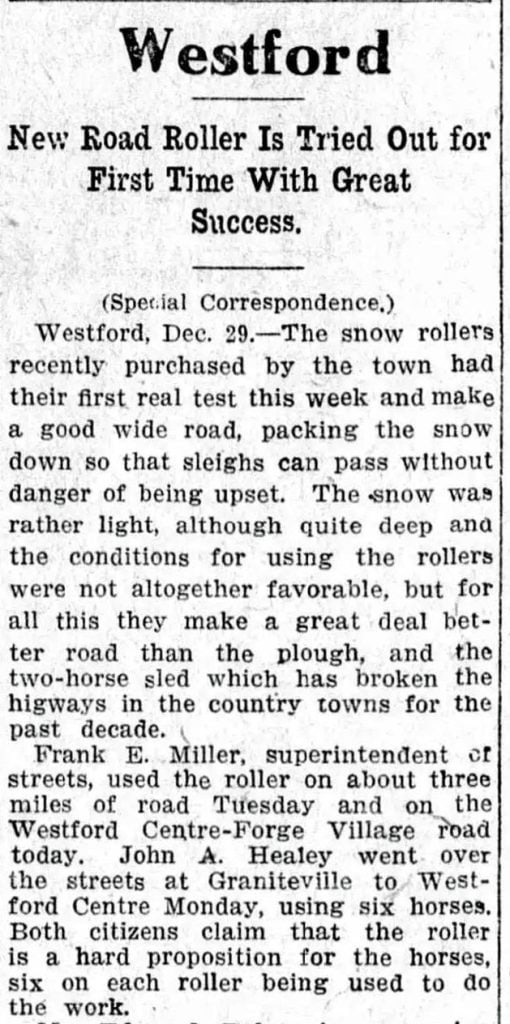
Westford Wardsman, January 1, 1910. “Center. It has been a very hard week for the R.F.D. carriers, but they have managed to cover their routes each day, of course, not being able to make their usual time.
We wonder if even the oldest inhabitant has anything to say just now about not having the winter weather that was experienced in former times. Sunday’s storm seemed the real thing. In places on our hilltop, where the wind has full sweep, the drifts were something to be remembered. There were few pedestrians or teams out. All who could were glad to make it a fireside day. The board of selectmen and road superintendent Miller had several gangs of men out Monday shoveling and clearing roads, and Tuesday, Mr. Miller had the snow roller with four horses abreast making rounds, and they did effective work. The car service on the branch line has been tied up and has been seriously missed.”
Lowell Courier Citizen, December 30, 1909, p. 7
From the Lowell Courier Citizen, January 18, 1910, p. 8. “Westford, January 17 – The snow rollers were again used on the highways yesterday and Saturday to the Centre of the town and to Forge Village and made the usual good roads.”
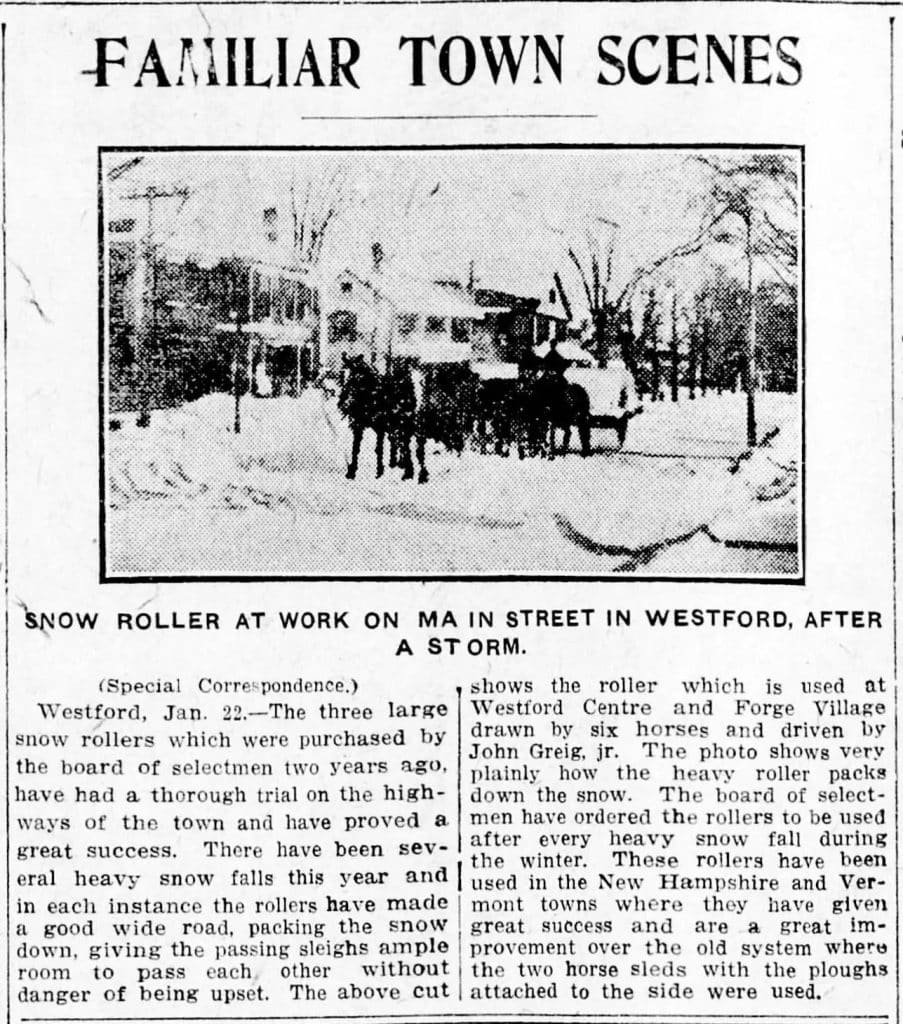
The following article appeared in both the Lowell Courier Citizen, February 15, 1910, p. 8, and the Westford Wardsman, February 19, 1910:
“Graniteville. The village people are just recovering from another severe snowstorm, which made traveling rather difficult for a time. The snow roller was out once more and appeared to do good work. It has been found necessary to bring the snow roller to use on several occasions this winter, and the chances are favorable that it will be used many more times before spring.”
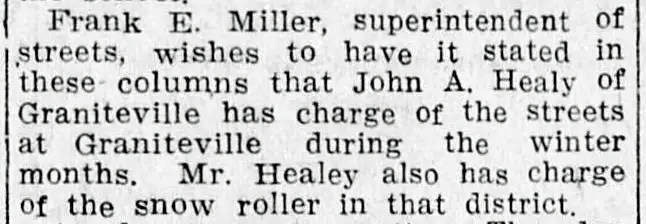
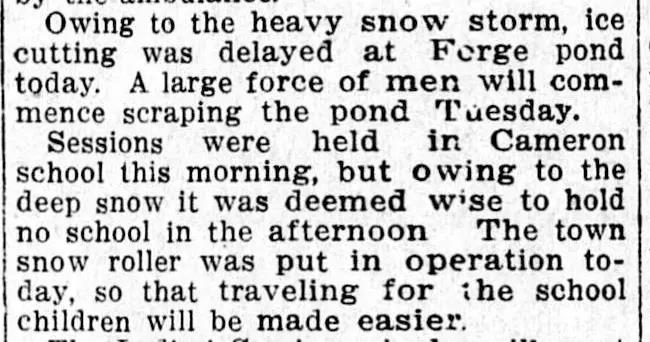
Westford Wardsman, January 20, 1912. “Forge Village. Cameron School held one session on Monday owing to the snowstorm. The town roller was at work to facilitate the traveling for the school children.”
Westford Wardsman, February 19, 1916. “Storm. The hard snowstorm of last Saturday and Sunday proved the worst of the season, fully twelve inches of snow falling. There was cause for gratitude that there was no serious amount of wind to cause too heavy drifting. It was a hard proposition for the branch line electrics and the faithful crew worked valiantly up to their limit of strength until it was inadequate to the situation. About noon Sunday, Supt. McDonald, with the town teams, was called out and went over the route, but the body of snow, which was damp and freezing to the rails, was so much that it was not until Monday morning when Supt. Cushing had the big snow plow sent across the grade crossing at Brookside that the line was really cleared. Monday being town meeting day this was especially desirable. Supt. McDonald also did a good amount of work with the big snow roller purchased by the town some years ago, going over the roads.
It goes without saying that church services were sparsely attended, although at the Congregational church, a service was held with an audience of less than a dozen people.
Forge Village. The winter’s heaviest snowstorm struck here last Saturday, continuing into Sunday evening. The sidewalks were kept clear throughout the storm through the kindness of Stephen Healy. On Monday, the town roller was used on the snow, which made the roads easier for travel.”


Westford Wardsman, February 26, 1921. “Center. The truck with snow-plow attached did good work in clearing the streets after the snowstorm last Sunday.”
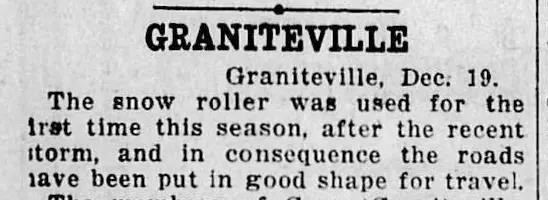
Finally, the town report for 1920, page 28, showed under the category of “Breaking Roads,” that the town now owned a Good Roads Mach. Co. road scraper which had cost $250.
The budget for snow removal during the 1920s ranged from $1500 to $2000.
The new Superintendent of Highways, J. Austin Healy, wrote in his report in the town report published in 1923, “I believe the tractor is one of the best purchases the Town ever made. It does more and better work at a less expense on scraping roads. Its use in the removal of snow not only means less expense but it does it quicker and better.”
The 1926 town report showed the town-owned:
2 5-Ton Holt tractors with Sargent snow ploughs
1 Truck snow plough
Also, from 1926, “The public must bear in mind that there is over one hundred miles of road and every road can not be cared for at the same time,” J. A. Healy.
In 2024, the town of Westford has 155 miles of accepted roads. Kyle Fox, Director of Public Works for the Town of Westford, states, “We currently have 29 pieces of equipment available for winter maintenance operations.”
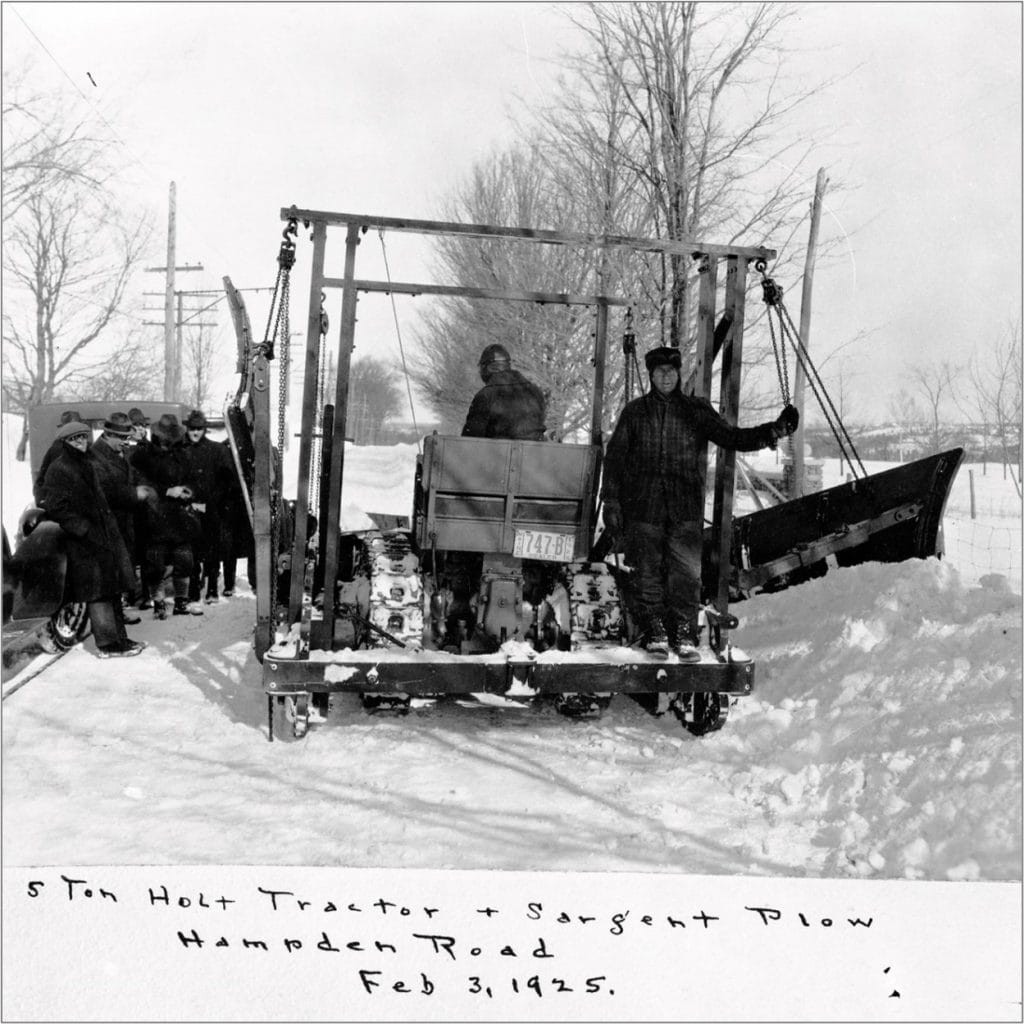
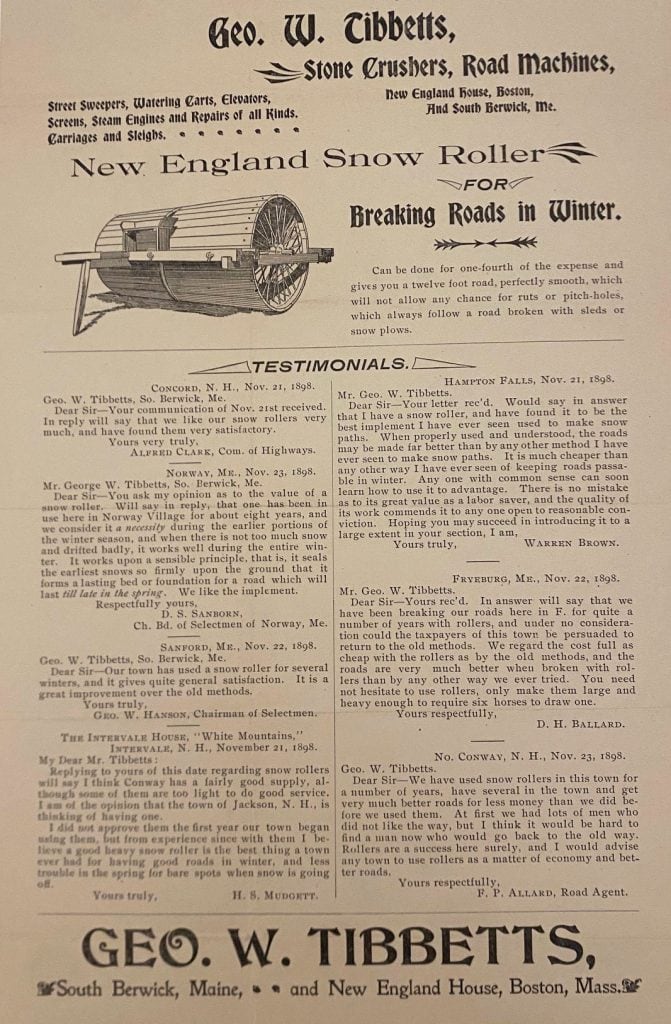
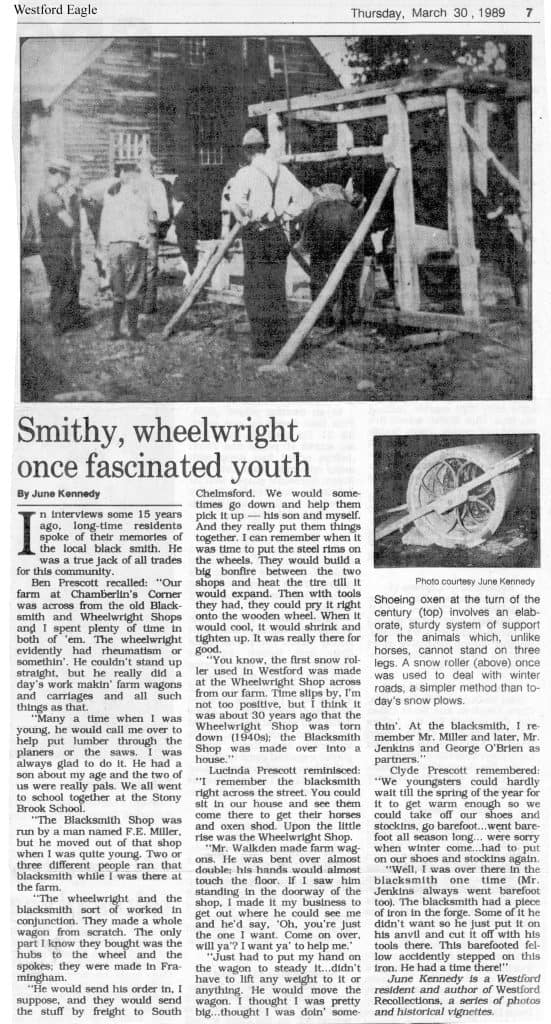
Thank you to:
The New Hampshire Historical Society for the Tibbetts broadside.
Robert J. Oliphant for sharing the Westford Wardsman articles.
Bob Oliphant’s Weekly Westford Wardsman Podcasts – The Westford Historical Society & Museum
Further reading:
Hovey, Richard. Snow Rollers of Vermont. Half Century of Snow Rolling in Vermont. Create Space, 2015.
